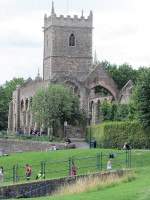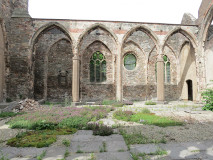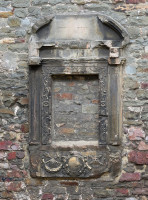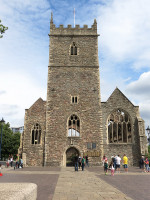 St Peter's Church, Castle Park.
St Peter's Church, Castle Park.
 St Peter's Church, Castle Park.
St Peter's Church, Castle Park.
The impressive ruined church of St Peter stands as a sort of war memorial in Castle Park. The castle is long gone, and the church could easily have preceded it, as in the mid-17th Century it was considered too close to the castle and planned for demolition. But it survived intact until WW2 bombing reduced to the tower and the shell of the body of the church. The main structure was medieval, and the entrance beneath the tower, which is still extant, is 15th Century. The tower itself, reconstructed at the top in 1657, is at its base true Norman, with massively solid walls. The nave, roofless, but with the outer walls complete and the dividing Gothic arches between nave and aisles, is medieval, apparently of mixed dates, with elegant windows and some surviving tracery, best on the south side of the church. Of the ‘small clustered columns with 15th Century capitals’ which once occupied the interior, peering through the door we can see only one in undamaged state.
At one time, the church was known for its many medieval brasses. These disappeared over time, but in late Victorian times there still
survived that of the priest Robert Loud, d.1461, showing his image carrying a chalice, and three to the memory of Andrew Norton, d.1527,
and his two wives. Two of the monuments were described as follows:
‘In the middle aisle a sumptuous tomb, with the kneeling figures of Richard Aldworth, d.1634, and his wife, who resided in the
ancient house adjoining the church, now called St Peter’s Hospital.’
‘The rich tomb of the family of Newton, perhaps Athalin, wife of John Newton, d.1599… a storied monument of costly workmanship,
having a canopy supported by six fluted pillars, whose one-time gilded capitals are now disfigured by whitewash.
Upon the sculptured sarcophagus comprising the tomb lies the effigy of a lady in quaint costume of the reign of James I’. ..’
At the foot of this sumptuous memorial is a humble but suggestive memento mori in the form of a cadaver or skeleton, to the memory of
some unknown person.’ These and the other monuments in the church, including several wall tablets from the 17th Century, were destroyed in the WW2 bombing which left it as the ruin it remains today.
From the window, we can see one lone survivor, the carved stone frame of a wall tablet, with a ruined pediment.
We see a border of low relief stylised leaves and flowers, outer receding pilasters to left and right, and below,
an apron containing a roundel, perhaps once a shield of arms, and on one side a skull and crossbones, on the other,
crossed miner’s tools, presumably hinting at the source of prosperity of the deceased.
Also in Castle Park - St Mary le Port ruins // Temple Church, another Bristol ruin // Christ Church with St Ewen // St Stephen's Church // Statues along Broad Quay, Bristol
Sculpture in England // Sculpture pages // Introduction to church monuments
Visits to this page from 13 Mar 2014: 8,152
 Arches of the nave and aisle windows.
Arches of the nave and aisle windows.
 Remains of a wall monument in St Peter's.
Remains of a wall monument in St Peter's.
 Entrance; tower of 17th Century at the top, and Norman below.
Entrance; tower of 17th Century at the top, and Norman below.